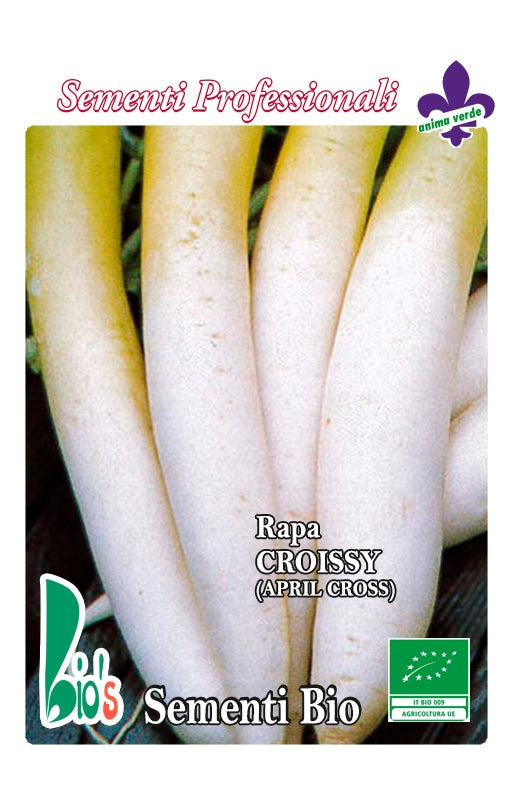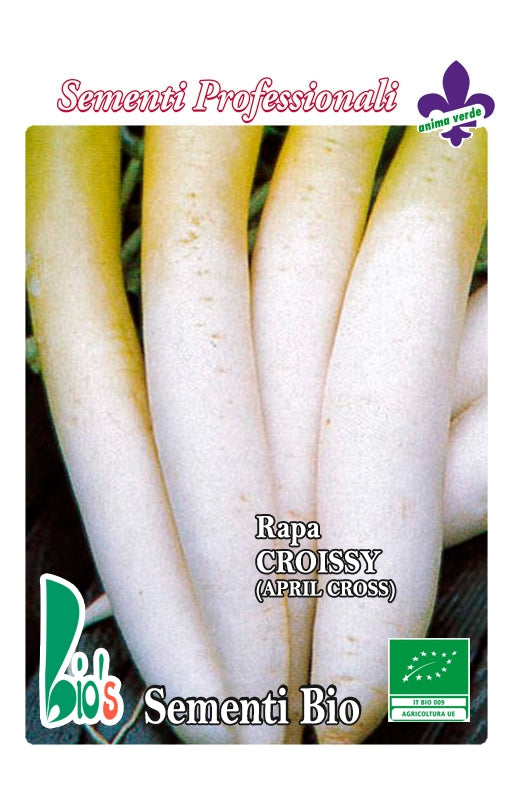Scientific name: Brassica rapa L.
Family: Cruciferae – Brassicaceae
Botanical characters
The Turnip (Brassica rapa L. subsp. rapa Thell.) is a biennial cruciferous vegetable (annual in cultivation) native to Western Siberia. In the first year it forms a fleshy root 5-10 cm in diameter, of various shapes and sizes (globose, globose-flattened, elongated); the color of the root is white yellow, with red, violet or green shades; the pulp is white and crunchy; the basal leaves are equipped with an elongated petiole with an entire, lobed or lyrate edge. In the second year it emits a branched flower stem about 80 cm high with lanceolate leaves; the hermaphroditic yellow flowers are gathered in umbrella-shaped racemes, have 4 petals, 6 stamens, a bilocular upper ovary which gives rise to a cylindrical silique, containing 15-20 spherical brown seeds. Fertilization is usually crossed. Environmental needs
The turnip adapts well to humid temperate climates and resists the cold well, down to -10°C. Flower induction occurs under long day conditions, therefore in spring.
It adapts to different types of soil, but prefers deep, fresh and well-drained soil, with a pH between 6.5 and 7.5 and low salinity. Nutrient needs are medium-low, while water needs are high.

Variety
The varieties are distinguished based on the shape and color of the root and the time of cultivation.
Cultivation technique
Cultivated mainly for autumn-winter production, it is generally planted from July to September after a spring-summer crop. It is sown broadcast or in rows 20 cm apart (manually or by machine), burying the seed at 1-2 cm. Sowing in January-February for spring production is rarer.
Cultural care
Cultural care includes weeding which can be carried out with weeding. Other treatments can include: thinning and irrigation.
The harvest takes place from October to March, 2-3 months after sowing; it can be scalar or contemporary when the roots have reached a diameter of 6-10 cm; they are then gathered into bunches and washed; production is around 300-400 quintals per hectare. The roots without the leaves can be stored in the fridge for 3-4 months.
Environmental needs
The turnip adapts well to humid temperate climates and resists the cold well, down to -10°C. Flower induction occurs under long day conditions, therefore in spring.
It adapts to different types of soil, but prefers deep, fresh and well-drained soil, with a pH between 6.5 and 7.5 and low salinity. Nutrient needs are medium-low, while water needs are high.
Adversity and parasites
Among the parasites that affect turnips we remember:
Cryptogames:
- Alternariosis (Alternaria brassicae);
– Cruciferous hernia (Plasmodiophora brassicae);
– Basal rots (Sclerotinia spp., Rhizoctonia solani, Phoma lingam);
– Cabbage mycosphaerella (Mycosphaerella brassicicola);
– White rust (Albugo candiada);
– Peronospora (Peronospora brassicae, Peronospora parasitica);
Bacteriosis:
– (Xanthomonas campestris, Erwinia carotovora);
Insects:
– Aphids (Myzus persicae) (Brevicoryne brassicae);
– Noctuaries, Cabbage birds (Mamestra brassicae, Mamestra oleracea, Pieris brassicae);
– Elaterids (Agriotes spp.);
– Altica (Phyllotreta spp.);
– Weevils (Baris spp., Ceuthorrhyncus spp.);
– Cabbage fly (Delia radicum).
Biodynamics
It is essential to use preparation 500 combining it with a mixed green manure, given the avidity of calcium it is useful to also use preparation 505 which contains calcium and sulphur.
Foliar spraying with silica horn 501 helps to stimulate the plant's defenses, warding off diseases.
Using the Biodynamic Calendar:
Sowing is carried out in the open field from July to September.
In the biodynamic calendar, in which the days AIR, WATER, LIGHT and EARTH are specified, i.e. when that type of processing has the greatest effect because the part of the plant that is of interest in the specific crop is favored. Thus the water days favor the leaf part of the plant, the earth days the roots, the air/light days the flowers and the light days the fruits.
Based on these indications, turnips prefer sowing on soil days (root organ)



